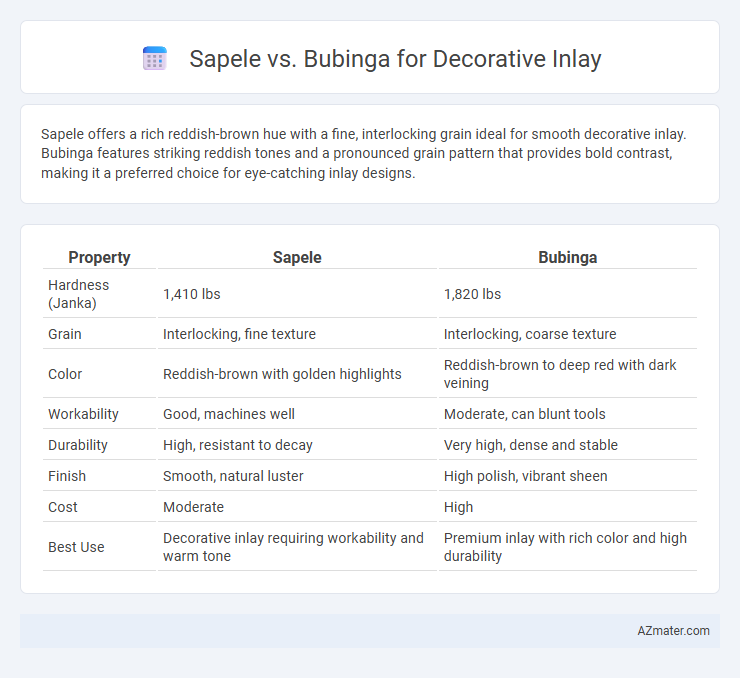Sapele offers a rich reddish-brown hue with a fine, interlocking grain ideal for smooth decorative inlay. Bubinga features striking reddish tones and a pronounced grain pattern that provides bold contrast, making it a preferred choice for eye-catching inlay designs.
Table of Comparison
| Property | Sapele | Bubinga |
|---|---|---|
| Hardness (Janka) | 1,410 lbs | 1,820 lbs |
| Grain | Interlocking, fine texture | Interlocking, coarse texture |
| Color | Reddish-brown with golden highlights | Reddish-brown to deep red with dark veining |
| Workability | Good, machines well | Moderate, can blunt tools |
| Durability | High, resistant to decay | Very high, dense and stable |
| Finish | Smooth, natural luster | High polish, vibrant sheen |
| Cost | Moderate | High |
| Best Use | Decorative inlay requiring workability and warm tone | Premium inlay with rich color and high durability |
Introduction to Sapele and Bubinga
Sapele is a durable African hardwood known for its rich, reddish-brown color and fine, interlocking grain, making it ideal for decorative inlay with a smooth, lustrous finish. Bubinga, another premium hardwood from Africa, features a striking deep reddish-brown hue with purple and black streaks, prized for its exceptional density and distinctive swirling grain patterns that enhance inlay detail. Both woods provide excellent workability and natural beauty, allowing artisans to create intricate, eye-catching designs in high-end furniture and musical instruments.
Origins and Botanical Differences
Sapele, originating from West Africa, belongs to the Meliaceae family and is renowned for its orangish-brown hue with a fine interlocking grain pattern. Bubinga, native to Central Africa and also part of the Meliaceae family, displays a reddish-brown color with darker veining that creates striking patterns ideal for decorative inlay. Both hardwoods differ botanically in grain structure and color intensity, influencing the visual depth and texture in inlay work.
Appearance and Aesthetic Qualities
Sapele features a rich reddish-brown hue with a subtle golden shimmer and a fine, interlocking grain that produces a naturally lustrous surface ideal for decorative inlay. Bubinga offers a striking contrast with its deeper reddish-purple tones and bold, complex grain patterns, creating a dramatic and luxurious aesthetic. Both woods exhibit exceptional durability and polishability, but Sapele's consistent warmth suits softer, traditional designs while Bubinga's vibrant and intricate figure enhances ornate or statement inlays.
Workability for Inlay Applications
Sapele offers excellent workability for decorative inlay due to its fine, interlocking grain and smooth texture, allowing precise cuts and intricate detailing. Bubinga presents a slightly harder, denser texture, which may require sharper tools but provides durability and a striking visual contrast in inlays. Both woods hold finishes well, with Sapele favoring easier shaping and Bubinga delivering enhanced richness and depth to decorative accents.
Durability and Hardness Comparison
Sapele wood exhibits a Janka hardness of approximately 1,410 lbf, offering good durability and moderate resistance to wear in decorative inlay applications. Bubinga, with a higher Janka hardness around 2,300 lbf, provides superior hardness and exceptional durability, making it ideal for high-traffic or high-impact inlays. Both species resist decay well, but Bubinga's dense grain and hardness ensure longer-lasting decorative finishes under frequent use.
Color and Grain Patterns
Sapele features warm reddish-brown hues with a consistent, interlocking grain that offers a smooth, ribbon-like texture ideal for intricate decorative inlays. Bubinga boasts a deeper, reddish to purplish-brown color with dramatic, swirling grain patterns and occasional metallic shimmer, providing a bold and eye-catching contrast. Both woods excel in decorative applications, but Sapele's uniform grain suits subtle designs while Bubinga's striking patterns create standout statement pieces.
Finishing and Polishing Characteristics
Sapele offers a smooth grain with moderate porosity, allowing it to accept finishes evenly while providing a warm, reddish-brown hue that polishes to a natural luster. Bubinga has a denser texture with interlocking grain patterns, resulting in a glossy, mirror-like finish after polishing that highlights its rich, deep reddish-purple tones. Both woods require careful sanding, but Bubinga's hardness demands finer abrasives for a flawless surface, whereas Sapele's softer nature permits quicker polishing with less risk of burnishing.
Cost and Availability
Sapele offers a more affordable price point and greater availability compared to Bubinga, making it a practical choice for decorative inlay projects on a budget. Bubinga, known for its rich reddish-brown hue and striking grain patterns, tends to be more expensive due to its limited supply and higher demand in specialty woodworking. Both woods provide excellent durability, but cost and consistent availability often make Sapele the preferred option for large-scale or cost-sensitive inlay work.
Suitability for Decorative Inlay Projects
Sapele offers fine, consistent grain patterns and rich reddish-brown hues that enhance detailed decorative inlay work, making it suitable for projects requiring precision and warmth. Bubinga's pronounced grain, vibrant reddish-brown to purple hues, and natural figure provide bold, striking contrasts ideal for statement inlay designs aiming for visual impact. Both woods exhibit excellent workability and finishing qualities, but Sapele's subtle elegance often suits intricate patterns, while Bubinga excels in dramatic, eye-catching applications.
Conclusion: Choosing Between Sapele and Bubinga
Sapele offers a warm reddish-brown hue with consistent grain patterns, making it ideal for subtle, elegant decorative inlays that require durability and a smooth finish. Bubinga features a rich, deep reddish color with striking grain variations and a natural luster, perfect for bold, eye-catching inlays that serve as focal points. Selecting between Sapele and Bubinga depends on the desired visual impact and durability needed; Sapele suits understated sophistication, while Bubinga excels in creating dramatic, high-contrast design elements.

Infographic: Sapele vs Bubinga for Decorative Inlay
 azmater.com
azmater.com